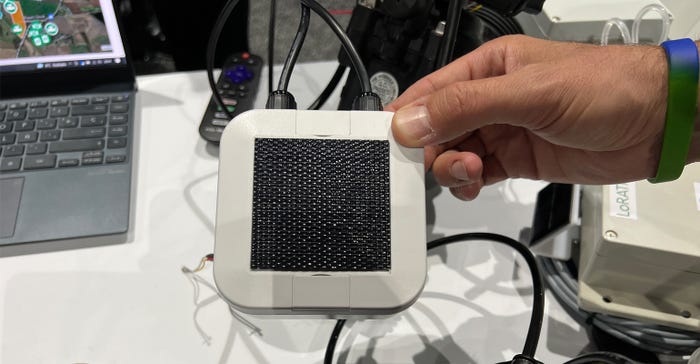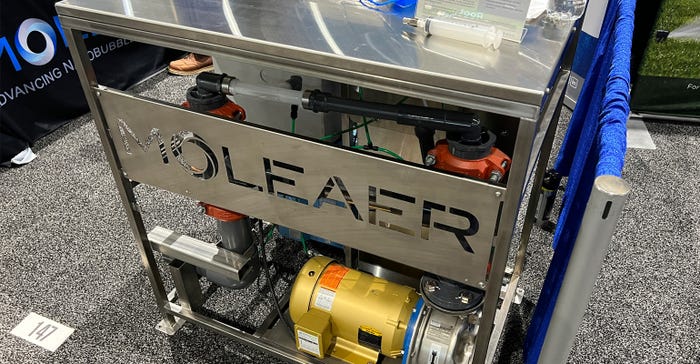December 23, 2021

The Irrigation Association has long fostered the development of new ideas and programs. For its 2021 Irrigation Association event, the group started its first ever Innovation Hub, allowing startups to exhibit, tell their story and possibly be singled out for recognition of their innovation. For agriculture, there were five startups in the pitch. Here's a look at each.
A buried sensor for better data. SoilTech has an interesting idea. The company has developed a tough sensor you bury, and it captures a range of information and sends it to the cloud — even from underground — in many instances. "We can measure soil moisture, temperature, humidity and provide geolocation information," says Ehsan Soltan, founder and CEO of SoilTech.
Sensors for the SoilTech system are encased in a durable material that allows the unit to be buried, but it can also be "harvested" — for example, with potatoes, which allows the unit go from field to storage and even to fresh pack-tracking. In the potato industry, this is essentially an electronic sensor potato.
 SMALL BUT POWERFUL: This Spherag sensor is solar powered and can connect to pumps, valves and other systems on the farm. It's part of a comprehensive cloud-based system that can help farmers better manage water and inputs.
SMALL BUT POWERFUL: This Spherag sensor is solar powered and can connect to pumps, valves and other systems on the farm. It's part of a comprehensive cloud-based system that can help farmers better manage water and inputs.

Soltan explains the unit can survive harvest and go into storage with the crop, adding new sensor value for the unit. There's a cover on the unit that must be removed when aboveground to capture storage conditions; but in the potato business, being able to do bruise spot analysis on the fly has value. And you can monitor crop storge with the unit, too.
The system can send alerts that you customize through the company application. It provides for multiple soil calibrations, postharvest field analysis and historical data logging. You can learn more at soiltechwireless.com.
Technology as a service. Altrac, a division of Semios, is offering customers irrigation management and other support for the farm as a service. From running wind turbines for frost management to monitoring a complete irrigation setup, Altrac staff would provide the support.
The idea of software and support as a service hasn't taken off in agriculture, but Altrac has staff on the ground already through Semios to make that happen. You can learn more at altrac.io.
Internet of Things actuator. Spherag, based in Spain, has developed a solar-powered tool that can link to a range of sensors for monitoring water use, fertigation and other sensors. The system combines an IoT device with a cloud service for improved irrigation management.
The innovative IoT tool can work with third-party sensor providers to communicate information from field to cloud for improved management, or the sensor can be integrated into the device for field-level insights.
Learn more at spherag.com.
High-tech hub. Vinduino has developed a comprehensive system to provide what the company calls "intelligent agronomy" for crop management. The system has artificial intelligence capabilities for water and crop management based on sensor inputs.
1220H2-1615C THINK SMALL: The nanobubble is small — 2,500 fit on a grain of sand — but Moleaer can effectively use nanobubbles to boost the content of oxygen in irrigation water, creating the potential for higher yields.
THINK SMALL: The nanobubble is small — 2,500 fit on a grain of sand — but Moleaer can effectively use nanobubbles to boost the content of oxygen in irrigation water, creating the potential for higher yields.

The opportunity for automating more decision-making in irrigation continues to grow. During the pitch presentation, the company noted the business could grow to $50 billion in the future. The rising need for more precise water management for high-value crops is a principal driver, and Vinduino has built products for vineyards and orchards.
Learn more at vinduino.com
Chemical-free, clean water. The irrigation industry has long struggled with impurities in water; and the use of chemicals, from copper sulfate to chlorine, has become just part of the business for many irrigators. Moleaer has developed a system that can purify water without chemicals using nanobubbles.
During his presentation, Chris Stephan, business development manager, shared that 2,500 nanobubbles would fit on a grain of sand — just to show the size of what their tech develops.
The company makes nanobubble generators that raise the oxygen content of water going to plants — which, Stephan explains, can boost productivity. "Nanobubbles are neutrally buoyant, stable, oxidative with good dispersal; and they have a negative charge, so they stick," he explains.
The idea of increasing dissolved oxygen in water has been around since the mid-1930s, Stephan says, and this new technology builds on the idea making use of fertigation in water more effective, too. The added benefit is that nanobubbles can disinfect water without the need for added chemicals, which improves payback on any system.
"You can grow more with less," Stephan says.
Learn more at moleaer.com.
About the Author(s)
You May Also Like






